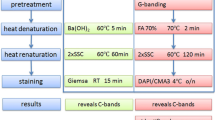Summary
C-band polymorphisms of chromosome 1 can be quantified by Ce bands visualized using oblique epi-illumination. In this paper the polymorphic region of chromosome 9, including variants such as 9qh+, inversions, and translocations, was analyzed in a total of 1860 chromosomes from 20 individuals and 8 fetuses. In this sample we found between zero and five Ce bands on 9q and between zero and four Ce bands on 9p with a maximum of five Ce bands per chromosome. On the basis of these observations at least 19 different polymorphic patterns can be expected theoretically, 15 of which were observed in our sample. Among these, five polymorphic Ce-band classes were distinguishable by the method presented. Considering both homologues, 52=25 quantitatively discernible chromosome 9 pairs may exist.
Similar content being viewed by others
References
Angell RR, Jacobs PA (1978) Lateral asymmetry in human constitutive heterochromatin frequency and inheritance. Am J Hum Genet 30:144–152
Azumi J, Nakagome Y, Matsunaga E (1979) A new approach in the evaluation of C-positive variants in man. Jpn J Hum Genet 24:99–104
Baliček P, Zižka J, Skalská H (1977) Length of human constitutive heterochromatin in relation to chromosomal contraction. Hum Genet 38:189–193
Benyush VA, Luckash VG, Shtannikov AV (1977) Quantitative analysis of C-bands based on optical density profiles in human chromosomes. Hum Genet 39:169–175
Brown T, Robertson FW, Dawson BM, Hanlin SJ, Page BM (1980) Individual variation of centric heterochromatin in man. Hum Genet 55:367–373
Buckton KE, O'Riordan ML, Jacobs PA, Robinson JA, Hill R, Evans HJ (1976) C- and Q-band polymorphisms in the chromosomes of three human populations. Ann Hum Genet 40:99–112
Craig-Holmes AP, Moore FB, Shaw MW (1975) Polymorphism of human C-band heterochromatin. II. Family studies with suggestive evidence for somatic crossing over. Am J Hum Genet 27:178–189
Drets ME, Seuanez H (1974) Quantitation of heterogeneous human heterochromatin: microdensitometric analysis of C- and G-bands. In: Coutinho EM, Fuchs F (eds) Physiology and genetics of reproduction, part A. Plenum Press, New York, pp 29–52
Enk D, Pawlowitzki IH (1987) An improved darkfield-illuminator for direct surface imaging for chromosomes. J Microsc 145:301–308
Erdtmann B (1982) Aspects of evaluation, significance, and evolution of human C-band heteromorphism. Hum Genet 61:281–294
Erdtmann B, Salzano FM, Mattevi MS, Flores RZ (1981) Quantitative analysis of C-bands in chromosomes 1, 9 and 16 of Brazillian Indians and Caucasoids. Hum Genet 57:58–63
Ford JH, Callen DF, Jahnke AB, Roberts CG (1982) Within pair differences of human chromosome 9 C-bands associated with reproductive loss. Hum Genet 61:360–363
Friedrich U, Therkelsen AJ (1982) An attempt to define 1qh+, 9qh+, and 16qh+. Hum Genet 60:139–144
Kiss P, Osztovics M (1981) Zytogenetische Untersuchungen bei 817 dysmorphischen Säuglingen. Z Gesamte Inn Med 36:356–360
Kunze J, Mau G (1975) A1 and C9 marker chromosomes in children with combined minor and major malformations. Lancet I:273
Lopetegui PH, (1980) 1, 9, and 16 C-band heteromorphisms in parents of Down's syndrome patients: distribution and etiological significance. Jpn J Hum Genet 25:29–37
Lubs HA, Kimberling WJ, Hecht F, Patil SR, Brown J, Gerald P, Summitt RL (1977) Racial differences in the frequency of Q and C chromosomal heteromorphisms. Nature 268:631–633
Madan K, Bobrow M (1974) Structural variation in chromosome no. 9. Ann Génét (Paris) 17:81–86
Madan K, Bruisma AH (1979) C-band polymorphism in human chromosome no. 6. Clin Genet 15:193–197
Matsuura J, Mayer M, Jacobs P (1978) A cytogenetic survey of an insolution for the mentally retarded. II. C-band chromosome heteromorphisms. Hum Genet 45:33–41
Müller HJ, Klinger HP, Glasser M (1975) Chromosome polymorphism in a human newborn population. II. Potentials of polymorphic chromosome variants for characterizing the ideogram of an individual. Cytogenet Cell Genet 15:239–255
Nielsen J, Friedrich U, Hreidarsson AB, Zeuthen E (1974) Frequency of 9qh+ and risk of chromosome aberrations in the progeny of individuals with 9qh+. Humangenetik 21:211–216
Paris Conference (1971) Supplement 1975: Standardization in human cytogenetics. Birth Defects 11, no 9
Park J (1976) Human C-band chromosomal polymorphisms: Frequency and distribution in Orientals. Thesis, Department of Medical Genetics, Indiana University
Patil SR, Lubs HA (1977) Classification of qh regions in human chromosomes 1, 9, and 16 by C-banding. Hum Genet 38:35–38
Pawlowitzki IH, Pfefferkorn G (1973) Eine Methode zur Darstellung der Gestalt von Chromosomenoberflächen im Lichtmikroskop. Exp Cell Res 80:27–30
Podugolnikova OA Parfenova IV, Sushanlo HM, Prokofieva-Belgovskaja AA (1979) The quantitative analysis of polymorphism on human chromosomes 1, 9, 16, and Y.I. Description of individual karyotypes. Hum Genet 49:243–250
Shabtai F, Halbrecht I (1979) Risk of malignancy and chromosomal polymorphism: a possible mechanism of association. Clin Genet 15:73–77
Soudek D, Sroka H (1979) Chromosomal variants in mentally retarded and normal men. Clin Genet 16:109–116
Tibiletti MG, Simoni G, Terzoli GL, Romitti L, Fedele L, Candiani GB (1981) Pericentric inversion of chromosome 9 in couples with repeated spontaneous abortion. Acta Eur Fertil 12:245–248
Tsvetkova TG (1980) Human chromosome polymorphism and reproductive failure. III. Extreme C-stained polymorphic variants of autosomes: distribution and combination in individual karyotypes. Genetika 16:2210–2216
Tsvetkova TG, Yankova MF (1979) Human chromosome polymorphism and reproductive failure. II. C-stained polymorphic variants of chromosomes. Genetika 15:1870–1879
Verma RS, Rodriguez J, Dosik H (1981) Human chromosome heteromorphisms in American Blacks. II. Higher incidence of pericentric inversions of secondary constriction regions (h). Am J Med Genet 8:17–25
Wahedi K (1986) Quantifikation von C-Banden-Polymorphismen durch Ce-Banden (zentromerische Elevationen) bei Chromosom 9. Thesis, Westfälische Wilhelms-Universität Münster
Wang HS, Hamerton JL (1979) C-band polymorphisms of chromosomes 1, 9, and 16 in four subgroups of mentally retarded patients and a normal control population. Hum Genet 51:269–275
Wegner H, Pawlowitzki IH (1981) Quantification of C-band polymorphisms by centromeric elevations (Ce-bands). Hum Genet 58:302–305
Author information
Authors and Affiliations
Rights and permissions
About this article
Cite this article
Wahedi, K., Pawlowitzki, I.H. C-band polymorphisms of chromosome 9: quantification by Ce-bands. Hum Genet 77, 1–5 (1987). https://doi.org/10.1007/BF00284704
Received:
Revised:
Issue Date:
DOI: https://doi.org/10.1007/BF00284704




